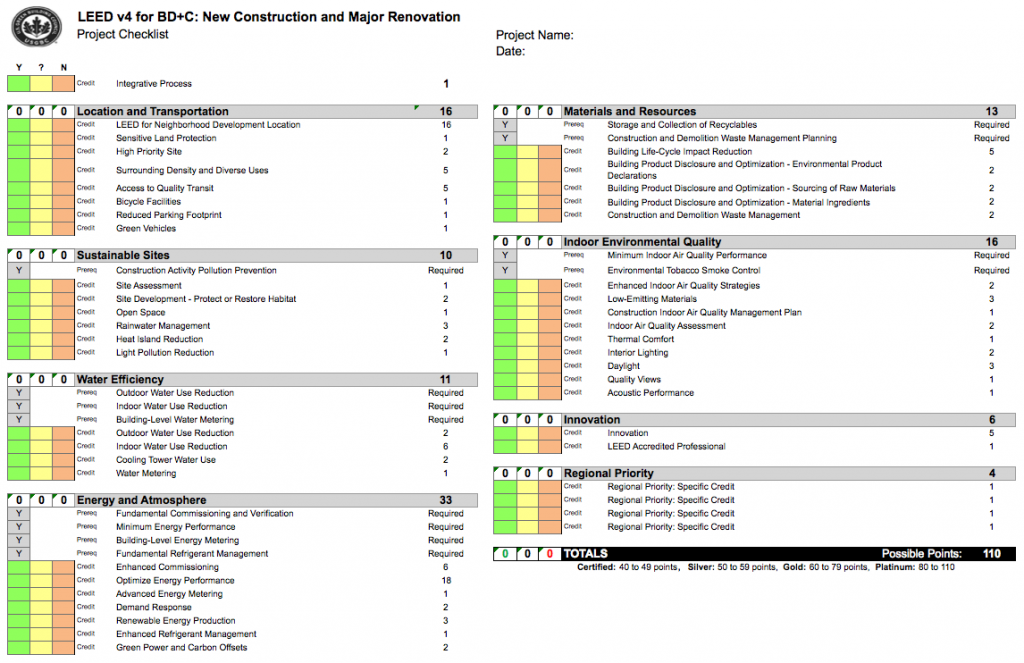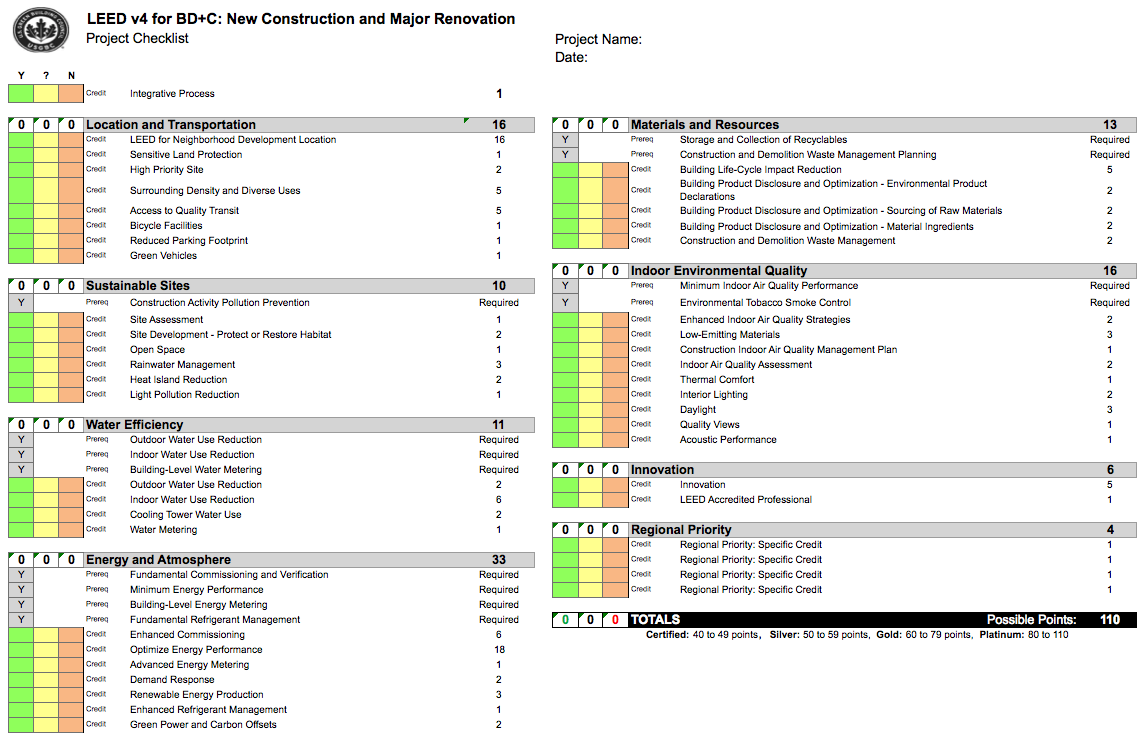LEED v4 is here. This latest version of the LEED rating system is “bolder and more specialized for building projects worldwide,” and it features more rigorous standards. While some of the credits and prerequisites are essentially the same as the 2009 version, there are some significant changes you should know about if a new build or renovation is in your future.
The United States Green Building Council (USGBC) announced it will allow LEED users to register projects under the LEED 2009 rating system until October 31, 2016. After that, new LEED registrations will only be accepted under LEED v4. Although the registration date was extended, the last day projects can submit for v3 certification — the sunset date — is still June 30, 2021.
What is LEED certification?
Leadership in Energy and Environmental Design (LEED) is a worldwide rating system devised by the USGBC to evaluate the environmental performance of a building and encourage market transformation towards sustainable design.
LEED Certification is a point-based system where a project can earn points for satisfying specific “green” building criteria. There are four levels of certification: Certified, Silver, Gold and Platinum. Each level requires a minimum amount of points and prerequisites. (Our own Stellar Commercial headquarters is certified LEED Silver, but I suppose it helps having 20 LEED-accredited professionals on staff!)
So what’s new in LEED v4? High-level changes include:
- Adaptations for global growth
- Market sector improvements
- Improved environmental outcomes
- More user-friendly interface
Let’s break down the big-picture highlights first, and then we’ll get to some changes specific to building design and construction projects.
Adaptations for global growth
Today, LEED projects can be found in more than 150 countries and territories, representing every continent except Antarctica. According to the USGBC, it has become “a common language of best practices in buildings around the world.” As a global company, we’ve seen how LEED has grown across different countries and cultures. Building facilities in different parts of the world comes with its own set of unique challenges, but LEED has certainly become a “language” that we can all speak.
This new LEED version caters to that growing global reach by being more flexible in recognizing regional context. For example, it now features regional and local equivalent standards so a project can achieve the same credit regardless of where it is located. LEED v4 also integrates metric units into all tools and resources.
Ultimately, the new version seeks to make LEED universal and flexible enough for project teams to use on a wide scale that isn’t limited by location or building type.
Market sector improvements
LEED v4 expands the rating system to include more building and renovation types. The expansion features 21 different market sector adaptations to address the unique needs of specific types of buildings.
The new version provides solutions for the following sectors:
- Existing schools
- Existing retail
- Data centers (new and existing)
- Warehouses and distribution centers (new and existing)
- Hospitality
- Mid-rise residential
The goal is to remove barriers so more facilities can participate in LEED.
Improved environmental outcomes
A central question drove the development of LEED v4: “What should LEED projects accomplish?” The new version establishes seven “impact categories” or goals for LEED projects moving forward:
- Reverse contribution to global climate change
- Enhance individual human health and wellbeing
- Protect and restore water resources
- Protect, enhance and restore biodiversity and ecosystem services
- Promote sustainable and regenerative material resources cycles
- Build a greener economy
- Enhance Social Equity, Environmental Justice and Community Quality of Life
The new version also increases thresholds in energy, water, waste and indoor environmental quality to “ensure LEED v4 projects are driving the goals of green building farther than ever.”
More user-friendly interface
A number of the improvements in LEED v4 come in the form of its online user interface. Key updates to online elements and workflow processes are aimed at saving you time.
The new LEED online portal is now easier to use, and it simplifies the requirements and process for submitting credits. This latest version also includes the option for the LEED Dynamic Plaque, which allows you to track a project’s LEED performance in real time. The platform measures building performance across five categories: energy, water, waste, transportation and human experience, and it generates a current performance score that is updated whenever new building data enters the platform.
Reference guides have also been restructured in LEED v4. The update now includes interactive web-based versions, which offer video tutorials and downloadable templates and presentations.
Of course, project paperwork is necessary, but it can often be time-consuming. In LEED v4, USGBC streamlined documentation so project teams can focus more on achieving credits rather than documenting them. For example:
- Forms for prerequisites and credits are now combined
- Downloadable calculators are available to increase transparency
- Less documentation is needed overall

Building Design and Construction (BD+C) changes
When it comes to the BD+C category, many of the changes in LEED v4 are focused on a project’s continued performance, rather than just its initial design. The new version also emphasizes site selection and provides extra incentive for integrated project delivery (IPD).
Let’s review some of the key changes in the BD+C credit categories.
1. Location and Transportation—This new credit category rewards projects for using a variety of transportation options and addresses sustainable communities. Projects can earn credit for building on a LEED Neighborhood Development site or on a “high priority site” to encourage use of sites with development constraints. Other credit updates encourage the availability of bicycle facilities, a reduced parking footprint and reserved parking spaces for green vehicles.
2. Sustainable Sites—This category encourages strategies to minimize impact on ecosystems and water resources. LEED v4 adds a credit for “Site Assessment,” which encourages assessing a site’s condition before design for features such as topography, hydrology, climate, vegetation, soils, human use and human health effects.
3. Water Efficiency—The Water Efficiency section is based on an “efficiency first” approach and addresses indoor use, outdoor use, specialized uses and metering. Outdoor water use reduction is no longer optional in LEED v4. In addition, building-level water metering is now a prerequisite, requiring each project to be capable of measuring whole-building water use.
4. Energy and Atmosphere—Similar to the Water Efficiency section, this category now includes building-level energy metering as a prerequisite, which requires each project to be capable of measuring whole-building energy use. Projects must now track the total building energy consumption at least monthly for five years and report the measurements back to the USGBC. For companies looking to improve energy efficiency, an energy assessment can identify common energy wasters and help achieve LEED certification.
5. Materials and Resources—This category has some of the biggest changes in LEED v4. The requirements in this section encourage the use of sustainable building materials and reducing waste on site to support a “life-cycle approach.” A new prerequisite requires setting a project target for waste management and requires reporting waste diversion rates. Also, a newly developed Building Life-Cycle Impact Reduction credit aims to lessen the building’s environmental impact. It encourages the reuse of historic buildings and the renovation of abandoned or blighted buildings.
6. Indoor Environment Quality—This category addresses design strategies and environmental factors that directly affect building occupants such as air quality, lighting quality and acoustic design. New in this category is “Enhanced Indoor Air Quality Strategies,” which includes a requirement for increased ventilation, as well as carbon dioxide monitoring, entryway systems, cross-contamination prevention, filtration and air contamination prevention and monitoring.
With more than 1.85 million square feet of building space becoming LEED certified every day, the rating system’s growth is undeniable. The updates in LEED v4 are nuanced and detailed, but the program is setting the stage for the future of green building.
You can view a detailed breakdown of credit changes and learn more by downloading the LEED v4 User Guide.

If you want to learn more about the new LEED v4, comment below!



